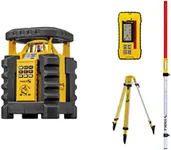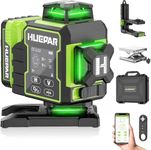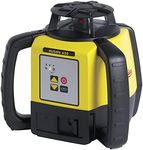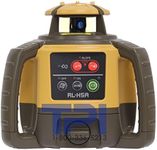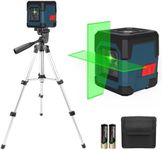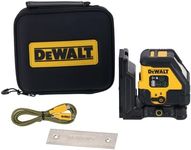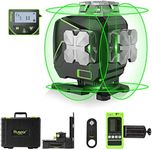Buying Guide for the Best Laser Levels
When choosing a laser level, it's important to consider the specific tasks you need it for, as well as the environment in which you'll be using it. Laser levels are essential tools for ensuring precision and accuracy in construction, carpentry, and DIY projects. They project a level line onto a surface, which can be used as a guide for various tasks. Understanding the key specifications will help you select a laser level that best suits your needs, ensuring efficiency and accuracy in your work.Laser TypeLaser levels come in two main types: red and green. The color of the laser affects visibility. Green lasers are generally more visible than red lasers, especially in bright conditions or over longer distances. If you are working outdoors or in well-lit areas, a green laser might be more suitable. However, red lasers are often sufficient for indoor use and are typically more affordable. Consider where you will be using the laser level most frequently to determine which type is best for you.
RangeThe range of a laser level indicates how far the laser can project a visible line. This is crucial for determining how large an area you can cover without moving the device. For small indoor projects, a range of up to 30 feet might be sufficient. For larger projects or outdoor use, you might need a range of 100 feet or more. Consider the size of the spaces you will be working in to choose a laser level with an appropriate range.
AccuracyAccuracy refers to how precise the laser level is in projecting a straight line. This is usually measured in terms of deviation per distance, such as ±1/8 inch at 30 feet. Higher accuracy is important for tasks that require precise alignment, such as installing cabinets or laying tiles. If your projects demand high precision, look for a laser level with a smaller deviation value. For less critical tasks, a standard accuracy level may suffice.
Self-LevelingSelf-leveling is a feature that allows the laser level to automatically adjust itself to ensure the line is perfectly horizontal or vertical. This is particularly useful for saving time and ensuring accuracy, as it eliminates the need for manual adjustments. If you frequently work on uneven surfaces or need to set up quickly, a self-leveling laser level is a good choice. For simpler tasks or if you don't mind manual adjustments, a non-self-leveling model might be adequate.
Beam OrientationBeam orientation refers to the direction in which the laser projects lines. Common orientations include horizontal, vertical, and cross-line (both horizontal and vertical). Some models also offer 360-degree projection. The right orientation depends on your specific needs. For example, cross-line lasers are versatile for most indoor tasks, while 360-degree lasers are ideal for large spaces where you need a continuous line around the room. Consider the types of projects you will be undertaking to determine the best beam orientation for you.
Durability and Weather ResistanceDurability and weather resistance are important if you plan to use the laser level in harsh conditions or on construction sites. Look for models with robust construction and features like water and dust resistance, often indicated by an IP rating. A higher IP rating means better protection against the elements. If you work outdoors or in challenging environments, prioritize a laser level with high durability and weather resistance to ensure longevity and reliability.

